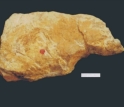News Release 04-131
Out of Africa: Scientists Find Earliest Evidence Yet of Human Presence in Northeast Asia

Overview of the oldest excavated archaeological stratum at Majuangou, with stone artifacts and f ...
September 29, 2004
This material is available primarily for archival purposes. Telephone numbers or other contact information may be out of date; please see current contact information at media contacts.
Arlington, Va.—Early humans lived in northern China about 1.66 million years ago, according to research reported in the journal Nature this week. The finding suggests humans—characterized by their making and use of stone tools—inhabited upper Asia almost 340,000 years before previous estimates placed them there, surviving in a pretty hostile environment.
The research team, including Richard Potts of the Smithsonian Institution’s National Museum of Natural History, reports the results of excavating four layers of sediments at Majuangou in north China. All the layers contained indisputable stone tools apparently made by early humans, known to researchers as “hominins.”
The top layer, located about 145-148 feet deep in the Earth’s soil, contains the oldest known record of hominin stone tools, dating back to 1.32 million years ago. But the fourth and deepest layer, in which Potts and his team also found stone tools, is about 340,000 years older than that.
According to Potts, “Because the oldest layers show humans made tools and extracted bone marrow like early people in Africa, the Majuangou evidence suggests strong connections with African hominins and their rapid spread across Asia.”
All four sediment layers the researchers examined contained evidence that early humans used stone tools to strike other stones, most likely to fashion chopping and scraping tools. In the three deepest layers, the stone tools are made of rocks unlike those in the surrounding sediment, indicating the Asia humans transported the rocks from another place. It also appears these humans used their tools on bones of deer- and horse-sized mammals, perhaps to butcher them for food.
According to Mark Weiss, physical anthropology program director at the National Science Foundation, which funded the discovery, “This research is helping us gain a picture of the adaptability of humans as they evolved and moved out of the tropics and into other environments.”
The research team used rock-magnetic dating methods to establish the age of the artifacts collected at the Majuangou site and compared them to the soil history of a nearby site that contained a more-complete record of sediment deposits through time. Factoring in other known geological events, such as the natural movement of the Earth’s magnetic poles over time, the scientists pieced together a detailed age sequence for the archeological levels.
These findings suggest that humans reached northeast Asia earlier than scientists had previously thought. Furthermore, the Majuangou site evidence is only slightly older than evidence found at the same latitude in western Eurasia and about the same age as the earliest known human fossils found in southeast Asia. This implies that African human populations came to Asia and spread rapidly to many areas.
-NSF-
-
Stone artifacts and modified bones from Majuangou. Top left, nortch made on a flake. Top right, ...
Credit and Larger Version
Media Contacts
Elizabeth Malone, NSF, (703) 292-7732, email: emalone@nsf.gov
Program Contacts
Mark Weiss, NSF, (703) 292-7321, email: mweiss@nsf.gov
The U.S. National Science Foundation propels the nation forward by advancing fundamental research in all fields of science and engineering. NSF supports research and people by providing facilities, instruments and funding to support their ingenuity and sustain the U.S. as a global leader in research and innovation. With a fiscal year 2023 budget of $9.5 billion, NSF funds reach all 50 states through grants to nearly 2,000 colleges, universities and institutions. Each year, NSF receives more than 40,000 competitive proposals and makes about 11,000 new awards. Those awards include support for cooperative research with industry, Arctic and Antarctic research and operations, and U.S. participation in international scientific efforts.
Connect with us online
NSF website: nsf.gov
NSF News: nsf.gov/news
For News Media: nsf.gov/news/newsroom
Statistics: nsf.gov/statistics/
Awards database: nsf.gov/awardsearch/
Follow us on social
Twitter: twitter.com/NSF
Facebook: facebook.com/US.NSF
Instagram: instagram.com/nsfgov



